| Peter Upton's
|
Subbuteo Tribute
Website.
|
The Illustrated Accessories List.
|
Part 2 The Continental Range. |
C140 - C169. |
We've reached 1976-77 in our epic tour of the Wonderful World of Subbuteo, and the arrival of the crowning glory of the whole thing - the Subbuteo stadium. This is also the time that the remaining A-Z accessories were given "C" numbers - between C144 and C152. Not wanting to describe them again, they
really just merit a heading, and a comment on their
survival. Plus illustrations of any packaging with the new numbers. Clear? Good, and so without further ado:-
Box types:- There were two big changes in Subbuteo
packaging design during this era. Firstly, the word Subbuteo moved from upper
case to lower case. The grandstand seems to be the first accessory to see this
change, and it also occurs on the box sets. Secondly, the 1970s kicking
footballer, and related logos (sometimes a goalkeeper, sometimes just the ball)
are replaced by the hobby-crest logo. This had been seen earlier in the 1970s
(i.e. on the Subbuteo sound record sleeve), but it now took prominence. However,
the kicking footballer existed as far as C154, and also had a final appearance
on C165 in 1979. That might be an exception though.... However, "lower
case lettering" is a less catchy title than "hobby-crest", so that is what I'm
calling this era of boxes.
The Accessories.
C140: Stadium Grandstand.
Specially designed for the big match atmosphere, this superb model is moulded in green and tan; supplied with five spectator figures.

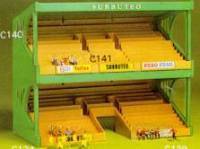
Having scoreboards, TV towers, ball boys, and other pitch side sets, I imagine the urge to produce the stands as well must have been overwhelming for Subbuteo in the 1970's. It must have been a mammoth task, but I think they got it absolutely
right as this is a beautifully designed grandstand. It arrived in 1976 at a cost of
£2.95, making it the most expensive item then available. The spectators (C141) arrived at the same time, but the terrace, and corner terrace arrived slightly
later in 1977. The stadium lived on into the "61" number years, but
was finally replaced in 1988 by the more modern looking red, white and blue stadium
(61216). The set was
originally sold with just five painted spectators, but later re-boxed ones also
included 25 unpainted spectators.


- Box types:- The original colour illustrated box is the most
common. I've never seen a monochrome-logo box in the flesh. It certainly was
not an improvement. The final box was in the green logo style, and featured
an action picture of Italy vs. Poland.
C141: Spectator Set.
Ten seated spectator figures to swell the attendance of the new stadium grandstand.



In truth, this didn't swell the attendance by very much. However you placed them, they still looked lonely.
The original catalogue picture (above) is just the chaps from the Bench Set (C139) painted in different colours.
Website helper Ashley Hemming still has his original bagged set from 1977, and
it shows that this original picture is correct. The bench/deck chair users were
originally supplied.
However, there were soon five newly designed figures in the usual packs, each painted in two standard variations using a minimum number of colours. They
were:-



- Man with both hands raised, open mouth and sideburns (or very big ears).
He's wearing a natty pullover covering a shirt. Both have grey trousers and black shoes. One wears a red pullover and a deep yellow shirt. The other has a dark blue pullover and a white shirt.
- Unexcited man with hands in lap. Both types wear a short dark blue coat, a brown hat, grey trousers and brown shoes. One has a yellow scarf/necktie, the other has a red one.
- Even less enthused man with folded arms and a roll-neck sweater. Both types have brown trousers and black shoes. One wears a red jumper, the other wears a light blue one.
- Man with one arm raised, open mouth and a big scarf. Both have grey trousers and brown shoes. One has yellow shirt and dark blue
scarf. The other has a light blue shirt and red scarf.
- Finally, a woman with both arms raised, bent at
the elbows. Here, the colours are reversed, so one has a green shirt, red trousers and green shoes, the other red shirt, green trousers and red shoes. Bizarre.
Occasionally she will have brown shoes to match her hair (by less
radical painters).
From my experience, this is the usual colour mix from the earlier
packs. I've added a couple of variations to my picture to show the changeover
from the 1970s dark red to the brighter one of the 1980s (important to consider
with hand-painted teams). In addition, the sky blue figures can
be painted in the original light blue of ref 5, or the deeper shade seen on
teams like ref 314.
Later packs are painted
differently, and often more sensibly (blue jeans and white shirts for
instance). The second picture shows a few other examples that I have
repeated. The ladies wearing a red and orange combo (rather than green) seem to
be early in date. I have several with red shirt and orange trousers, but the
only reversed one I own is still in a sealed bag. When the cheering gentleman with the
tank top has a white shirt, he always seems to have brown hair, whereas with the yellow shirt his hair is black.
Obviously it was going to take a lot of these packs to fill a stadium. To try to solve this, a later pack of fifty supporters were produced (C168), but you had to paint these yourself. The painted spectators did get a "61" number, but were phased out in favour of the unpainted ones by
1990.


- Pack types:- Originally sold in a bag with a header card, the
supporters were also sold in bubble packs with all three backing cards
(early and late are shown).
- The late pack type is shown with both red and blue colour coding.
C142: Stadium Terracing.
Two terracing units complete with supports to add to your Stadium Grandstand.


A cheaper way to enclose your ground, this was basically just the two tan coloured tiers of seats from the grandstand, with small plastic uprights to hold up the back. It was a credit to the stadium design that this worked so effectively.
With the original version of this set, no more spectators were provided so you
had to fork out for a few more C141s. When it was re-boxed in 1984 twenty-five
unpainted crowd figures were added. This set survived alongside the green/tan
grandstand, but when the new stand was produced in 1988, it was changed to
a grey version and gained a new number - 61217.


- Box types:- Like the grandstand, I think there are
three types, with variations. The original hobby-crest version is the most
common, but had an early variant shown below.
- The set then moved onto the monochrome logo (1981-83), before
appearing in the green-logo box. A late version of this box is shown above,
advising that the set now included twenty-five unpainted crowd figures. The
1988 catalogue saw the arrival of both the red-logo boxes, and the new
colour stands, so I don't think this reference appeared in that style of
box.
- July 2023: As with the corner terrace below, two variations of
monochrome logo box have now been sighted. For a short-lived and quite
unusual box type, this is a little crazy. However, Subbuteo did change
addresses a couple of times in this era, and it is likely that the box was
tweaked to show the contents (two terraces) on one of these reprints.
Alternate Early Version.


This is a strange thing. This early version of the terrace set has
the terrace supported by two ball raising chutes (Set
JJ). I would have put this down as a bit of enterprise by the previous
owner, if the back of the box didn't illustrate how to apply them. I guess we
now know why the ball raising chute does not make it into the "C"
range in 1977. The remaining stock was put to a different use!
C143: Stadium Terracing Corner Unit.
...to enable you to complete your stadium.


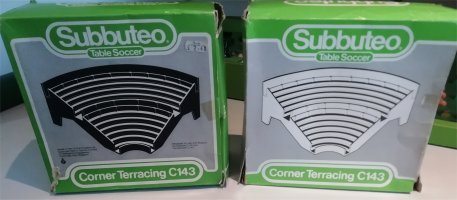
The final piece in the
stadium jigsaw, which allowed all us young Subbuteo fans to dream of owning a fully
enclosed stadium. Of course, if anyone had ever managed to surround the whole pitch, they would have
run into several difficulties. Firstly, of course, you couldn't get near to the pitch to actually play the game. Then, the goalkeeper controllers would hit the
terracing, unless you made the stadium even bigger. In all the catalogue
pictures of stadiums, this is never addressed. The teams either have goalkeepers
without rods (1981 is a good example) or the poor kid playing has the goalkeeper
rod poking out of the side of the goal, in a way that would never work...
In addition, the scoreboard disappears behind the
stands, and where do you put the TV Tower? This set went through the same design
change as the normal terrace - becoming 61218
once it was changed to a grey colour
in
1988.

- Box types:- Again, I think there are
three basic versions, with the original hobby-crest version by
far the most common (shown above, left).
- The monochrome-logo style of box arrived circa 1980. Website helper
Ashley Hemming realised he had two alternate versions of this box, with
the terrace shown in both black and white. (see above). Very weird. You can see
that the darker version has more writing on the front. This explains that
the set is made in the UK, and is designed for use with C140 and C142.
However, it also gives the address as Chiddingstone Causeway, Tonbridge, so
this is the earlier version of the box. Ashley's pale box has the Leeds
address on the back.
- The final green logo version once again had the Italy vs. Poland
picture, with just a small picture of the accessory.
C144: Three Panelled Balls.
Previously Set F.

The new number was granted in 1977. Had departed the range by 1985. Note the change from two panels to three. Oh the excitement of it all....






- Pack types:- Originally sold in a bag with header card, identical
to the Set F version. The kicking footballer logo version has been seen as
C144F and C144. The brown balls have appeared in these late 1970s packs as
C144, but the balls are still two panel at this stage.
- The bagged balls here are the original two panel version.
- They were sold as Panelled balls
in all three types of bubble pack.
- Orange and white balls in the thinner three panel version have been seen
under this number. I'm not sure the brown was produced in the three panel
balls.
- The white ball was sold as 61144 in 1984-85.
C145: Three Small Balls.
Previously Set FF.


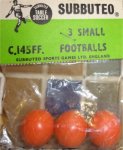
As with C144, this
set transferred over from the old letter range with minimal impact - the header
cards are near identical. At this point, these were still the old "two panel"
balls in all three colours. The set was still available in a
three panel orange version as late as
1985, which earned the set a 61xxx version. But they didn't last much longer than that. These small orange balls were also sold as
"Indoor Balls" in the NASL range of the early 1980s.




- Pack types:- Like C144, the header card/bag version just
transferred over. All those shown have a C145FF number.
- As the balls were sold until 1985, all three bubble packs will have been
used. Both white and orange balls have
been seen in the later three panel version.
- July 2023: Ashley sent me a picture of the two panel small brown balls
in the early pack, and it is illustrated. However, this pack had been
opened, so it isn't conclusive proof that the brown balls made it this far.
C146: Super Log Book.

Previously Set L.
Arrived on this number in 1977 at 49p, but
only for a single year. It was gone in 1978.
C147: Logbook Refill.
Previously Set LX.

This item managed to out last the cover by a couple of years,
and it still featured in the 1980 catalogue...
but it had gone by 1981. The final version is shown here.
C148:
De-Luxe Goals.
Previously Set N.

The box remained the
same, except for the new number. The new box called the set C148N, as did the
1977 price list. After that it was plain old C148. It was still on the 1983
price list, but didn't make it to 1985 and the "61" range. Of course
it still continued in the basic club edition of the game into the early 1990's.



- Box types:- Originally in the Set N box, with new
number as shown at the top of this section.
- The set then managed two distinct Falcon logo boxes from the Tonbridge
period with one goal shown in black, and then two goals in white.
- The goals get a monochrome-logo box in 1981-83. A lack of a 61xxx number means no green-logo box.
C149: Smaller Goals.
Previously Set
NN.

Again
the box is reprinted, but there seemed little point to it, because this time the
accessory had left the range by the time of the 1978 price list.
- Box types:- just the one shown.
- The goals were the same price as the slightly bigger C148. 75p in the
single catalogue appearance.
C150: Fixture Cards.
Previously Set U.

This is another item
with a single year appearance in this range. Priced at 15p in 1977 and gone in
1978. I've shown the revamped mid 1970s fixture card complete with
Football Express advert., as that seems to be the final version.
C151: Referee's Whistle.
Previously Set V.
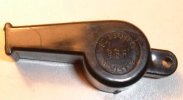
Another pointless renumber really, but
at least this item gets two years 1977 (at 25p) and 1978 (at 30p). Although it
had gone in 1979, Subbuteo did release a
new Referee's kit (C166) in that year, and the whistle in that set seems to
be the same product.
C152: Automatic Timer.
Previously Set W.
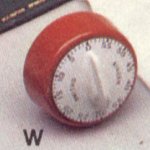
This expensive item
is ditto the fixture cards, small goals and whistle. Arrived in the
continental range in 1977, but had already ceased by the 1978 price list. Did
the new numbers really shift all the remaining stock of all these items? Did
they bother with a new box for this set?
C153: Diving Goalkeepers with caps.


There was no catalogue description to go with these, but then they
did not really need one. They were exactly as the name suggests. They are
actually a favourite design of mine as they possess a wide, stable stance. They
replaced the crouching goalkeepers in the range (and in the interchangeable
goalkeepers set). As they appear to have a slightly wider coverage than some of
the alternative goalkeepers, they were popular with players, and so must have
been a nice steady, simple money-earner for Subbuteo. See my illustration with
the usual diving version (in blue) for the difference. Obviously, they were much
more use than a crouching keeper.
They arrived in 1978 and remained in the range
until 1995. Like the standard goalkeeper, they received a peg base around 1985.
Given that they seemed popular, it is perhaps surprising to find that they were actually dropped to the "requests only" part of the price list in
1982-84, returning to the shop range in 1985 as the pegged figure. The 1985 price
list actually has them highlighted as a "new" item, although obviously they were
not. I think they were the only set that returned
to the
main range from the "request" list.
The later goalkeepers do not pick up the more exotic colours of
the diving/live-action keepers. They were generally sold as one yellow shirted keeper,
and one in pale blue. The large picture above shows a couple of slight
alternatives with the early keepers. These generally seem to wear a contrasting
cap, that (as with hair colour) tends to match the boots. So I have a keeper
with a black cap and boots, but also one with brown cap and boots (wearing black
socks). Later on, the caps match the shirts. That's better really, because the
black/brown caps just end up looking like hair.




- Box types:- The 1978 box was a mix of old and new. The
new "lower case" Subbuteo, but with the old kicking footballer
logo. It was essentially a "hobby-crest" box though. It had a nice close-up
of a goalkeeper in his cap.
- The set became "request only" in the monochrome logo box era, but
pleasingly did receive an updated box. This is shown above (front and back).
It features the same goalkeeper illustration as the original box, but loses
the close-up, which is a shame. Well done to Ashley Hemmings for spotting
this one.
- On their return to the full range in 1985, the goalkeepers
joined the other small accessories on bubble packs. Like the balls and cups, they were
then re-boxed in the
1990s "pitch-corner" range.
C154: Tournament Goals.
With round posts and crossbar, and bases for extra stability.

The first new goals
since the 1973/4 World Cup ones (C130), this set arrived in 1978. Like the World
Cup goals, there were no back supports, but the posts are thicker, and they
don't seem as prone to bending backwards as the World Cup goal. They replaced
C122 in the range, and like that goal these had round posts, and a multi-part
construction on green bases. However, they were much more robust, and the bases
more compact.
The early goals were assembled by Subbuteo, but
later when the self-assembly goals arrived, these two arrived flat-packed. The
net colour of these goals is usually white. They were white for the first
catalogue appearance in 1978, but are shown with a different colour net in the
1979 catalogue. I think it is probably the dark blue "World Cup" net that they
are shown with.
Once again, this was a nice simple set, that
lived on until the last big
accessory range of 1995. They also appeared in some of the bigger sets of the early
1990s.



- Box Types:- Five. This popular goal
arrived in the late 1970s style of box. Like C153, this still had the
kicking footballer logo, but the lower-case lettering, and illustration fit
into the hobby-crest era. As the goal survived until 1996, it then featured
in all the other box types - monochrome-logo, green-logo, red-logo, and
pitch-corner.
- As usual, the pitch corner picture was amended to show the contents
(i.e. a pair of goals).
C155: Subbuteo World
1978-1981.
The comprehensive list of the Subbuteo range.
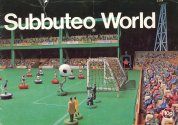
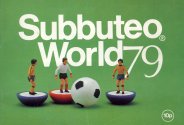
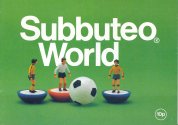
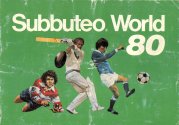
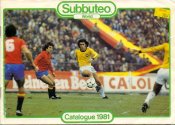
The Subbuteo catalogues changed in
1978 from a fold out poster of team colours with accessory details on the back,
to a full blown colour illustrated catalogue. This new catalogue was made
available to buy in the shops. My 1981 version cost me (or probably my
mum!) the princely sum of 20p. The catalogue was given the C155 number in 1978,
and this number carried on through the four versions of this catalogue until 1981. After
that, Subbuteo changed back to producing posters of the range for several years. I've now added a couple of pages of catalogues
to the website, so you can check out what was produced for each year.
- The 1979 Subbuteo World catalogue has a variant
cover with no date on it.
C156:
T.V. Film Unit.
A set of two cameramen, sound recordist, and ground microphones.
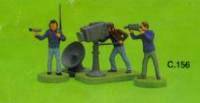

Introduced around
1979. With TV coverage becoming more widespread, this was a nice set of more modern looking cameramen to go with the TV Tower (C110).
It became an "order only" set in 1983, and then disappeared from the
range in 1984. But the contents returned in 1985 in 61208,
which was a combined set with the brown TV
tower.
C157: Subbuteo World Cup.
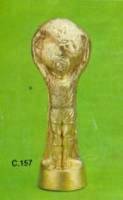

This short-lived set is a bit of a mystery. It
first arrived in the catalogues in 1979. The Jules Rimet trophy had remained the
Subbuteo World Cup to this point, although a new trophy had been designed for
the 1974 competition after Brazil won the original outright in 1970. Although
the new World Cup did feature a globe being held aloft, it looked nothing like
this version, with a couple of players doing the lifting. It is possible that it
was an attempt to produce a trophy similar to
the new FIFA World Cup without paying for a licence. Previously, I wondered
whether it was a replica of the cup the Subbuteo World Champion received, but
no, that was still the awkward looking John Waddington trophy.
Charles Stadden had produced Subbuteo's version of
the Jules Rimet, but I have been told that he did not like the design of the new
trophy, and refused to copy it. Perhaps this was the result. Whatever the
reasons, this trophy was replaced by an official copy of the new FIFA World Cup
(C182) in 1981.
- The set only lasts for two years 1979 and 1980.
- The one box type is the Hobby Crest version
shown. This cup is the only one not to get a box insert.
- I have now illustrated the actual cup and box, but
left the old catalogue illustration as that appears to be a prototype.
If anyone can clear this up then please mail me.
C158: Stadium Scoreboard.
Fully working with name cards of all leading English and Scottish League Clubs...



It is somewhat surprising for me that this was only introduced
in 1978-79, such a widespread Subbuteo icon has it become. Although it looks a sleek modern device, it works in exactly the same way as the aged brown scorer (C115) it
replaced - just cut out the card name tags and spin the numbers. Don't score
eleven (or play American Samoa), because the dials only go up to nine.
The box shown here is an early design, and note that the illustration was not completely accurate,
with the board looking too long, and the legs shown as being on the
right on the ends. Actually, the design of the legs ended up being a bit
complicated. Because one of the legs had to slot in over the back of the dial
cover, that leg would end up slightly behind the other. So each leg was designed
differently to make allowance for this, and were then labelled A and B so you
put them in the correct side of the board. The
big legs also allowed you to place the board flush to the back of the terrace set
while still reading the scores. Very clever.
The second picture
above shows the pale blue version of the board, as produced for the Euro 96
box set. This was the only time the scoreboard wasn't produced in black.
The scoresheets
for this board were produced on black card with little white dots making up the
names, representing a digital display. These were initially in lower case, and
came on a single fold-out card. This "lower-case" set was copied from
the C115 cards, with only the English and Scottish leagues, World Cup sides, and
home nations. These scoresheets were updated for the 1982 World Cup, but replaced sometime in the mid-1980s with an international version.
This second
version was produced in capital letters, and consisted of 20 cards each
containing 26 team names, covering most of the leagues that Subbuteo provided
teams for (but not always the same teams....). So Vasco De Gama could now play
Athlone Town on your bedroom floor. The twenty cards remained until the set was
finally ceased at the end of the 1990s. However, they were updated on a frequent
basis. The most common reason for this was the introduction of relegation from
the English football league, starting with Scarborough replacing Lincoln City in
1987. These were just a straight swap on the list, so the alphabetical order
became a bit erratic. Other big changes included dropping the NASL teams, and
swapping World Cup qualifiers.

- Box types:- Five. The scoreboard runs through all the later box
types. The hobby-crest version is shown at the top of this section, then we
have monochrome logo, green and red
logos, and finally the pitch-corner. Note that the red logo version shown here has a "The
Football Game" sub-heading here (and green has Table Soccer). The pitch-corner box can have Waddingtons or
Hasbro address details.
C159: Police Squad.
A set of four policemen including a motorcyclist, and a figure mounted on a horse.


Introduced at the same time as C156, this
was another attempt to update the "stand around the pitch" range for the 1980's. These flat capped modern policemen replaced the
bobbies in C113. I think they were designed to give a more
European feel. Without the distinctive British helmets, these figures could be
sold anywhere... I'm not sure why the motorcyclist would be standing around the
pitch (unless someone has ordered a pizza). The set is on this number until
1986/87 when it became part of 61214, and it finally finished up in 61239 in
1996. It also appeared in the Match Day series (187/4). Buy all these sets, and
you have enough horses to produce the impressive slow march across the football field
to separate any marauding plastic fans. But if you want a truck with a water
cannon, you'll have to buy a Corgi one....
C160: Soccer Plotter.
A league chart showing all four divisions of the English League together with
removable self-adhesive Subbuteo team figures.

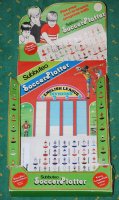
Another short lived
item, appearing in 1979 and 1980. Actually, it is just the sort of thing that appealed to me as a youngster, when my love of
statistics and tables made me keep those big World Cup progress charts on the wall. I guess the fact that Shoot! and Roy of the Rovers magazines used to give away league ladders, and season plotters each year, made a commercial version less viable.
Still a cup version was also produced in 1980 (see C176).
The self-adhesive figures were simply the
illustrations from the zombie catalogues of 1977-80. The 92 stickers were
provided alphabetically by division, which dates the leagues to the 1978-79
season. The kits date to the 1978 catalogue (for instance, Hull City are ref
35). Some kits reappear several times (reference 51 was five different sides in
the 1978 catalogue), but Subbuteo did a lot of quirky kits in this period, and
it is nice to see the individual kits for teams like Rochdale, Orient, York and
Cardiff. The same sticker sheet was used for the later Trophy Trail, but with
the team names removed.
- February 2015:- The counter display box for the Soccer Plotter
is now illustrated.
C161: Floodlight Mains Adaptor Unit.


Okay, how can I say anything exciting about this? It
did what it said, allowing you to run the floodlights from the mains rather than gobble up batteries.
In fact, it included wires to connect up four floodlights, so it was quite a good idea.
It doesn't feature on any of the product range posters later than 1982, but then it's not exactly gripping poster
material. It seems to drop to the reserve list on the 1983 price list (available
to order, but not readily stocked at shops), and disappeared a year later.
- Box types:- This accessory did receive a
hobby-crest box when first produced (as illustrated). I've not seen any
other boxes.
- The floodlight bases were updated to allow them to be wired
together.
- This was the most expensive item in the accessory range -
£6.50 on introduction in 1979, with two floodlights costing £5.99.
C162: EPNS Cup Large.
C163: EPNS Cup Medium.
C164 EPNS Cup Small.

Peter Adolph first introduced the
EPNS Cups (Electro-Plated Nickel Silver) circa 1960. There were originally
four cups, but this dropped to three in 1977. These cups were designed
as prizes for local leagues etc, so they were kept separate from the normal
range until 1979, when the three remaining cups became C162-C164. They were
illustrated in the 1979 catalogue, which was possibly the first time they'd
been illustrated since the 1960/61 catalogue. This 1979 listing is their
only appearance on the new numbers, and a price list dated 1st July 1979 already
has "sold out" printed next to all three. It's pure speculation, but
it's amusing to imagine that sales had trundled along at a low level for years,
until this catalogue appearance whereupon enough extra sales were generated to
exhaust the stock in a few months. Certainly as a newbie Subbuteo player in
1979, I thought the high "C" numbers indicated that these were new
items.
-
The remaining A-Z referenced accessories reached the "C" range
in 1977, and these cups were the final non "C" numbered items to cross over.
-
The 1978 price list actually still had prices for E300-302
Football Express items, plus the medals (bronze and silver) and the plaques.
None of those moved across of course.
-
I have a 1st February 1979 price list which prices the three
EPNS cups at £9.50, £3.50 and £2.50 respectively. As noted, all three had
sold out on the July list.
-
Oddly, the 1978 price list had them unreferenced at £10.20,
£2.85, and £2.43.
C165: Home International Team Pack.
Four team pack of England, Scotland, Wales, and Northern Ireland.

A follow-up to 1977's specially boxed home international teams (C500) this
set arrived in 1979. It put the teams back in the normal C100 boxes, but
at least gave them a large illustrated wrap. The last appearance of this set was
1981. Sadly, the real home international
tournament didn't last much longer than that. Earlier team wraps can now be seen
on the first miscellaneous items
page, and a final version was C174 the World Cup Winners Pack.
- I noticed that this item was still using the "kicking
footballer" logo, although surrounded by items with the hobby-crest logo.
- However, it also does not have the C165 reference on the pack
anywhere....
- The 1979 price list has "* new for 1979" against all
the new items. This was C156-C161 and C166, but not C162-64 (as the cups
were not new), and not C165 either.
- This suggests that it was not originally in this range. Which
may explain why the other wraps are not here. Oddly though, the Silver
Jubilee, and the European Championship wraps both have the hobby-crest logo.
C174, the World Cup Winners pack does not have a Cxxx number on the wrap
either.
C166: Referee's Kit.
Comprising a whistle, note book, red and yellow card.




Antagonize your friends by showing them red cards and blowing the whistle all the time. This little item ran from
1979 until 1983. It wasn't given a "61" number in the Waddington's clean-up, so that was that.
Strangely, two Italian website helpers have noticed that this set was sold in
Italy with a backing card calling it C000 - thanks to Lorenzo and Paolo for
spotting this :-)
-
As mentioned, this item only ran in the UK until 1983, and it
should be available on the first two backing cards...
-
However, it is still advertised as available in the Italian
catalogue of 1994 with a 61166 number. Old stock or new cards?
C167: Three Tournament Balls.
With "harlequin" spots, one red, one blue and one green.


Okay, so they were just C127 with coloured spots instead of black ones. Did it stop me buying them? No, and it probably alerted Subbuteo
to the quick bucks to be made with minor variations of ball. The bigger picture
shows my early version with stick-on spots, and you can see how much use I got
out of them!. The later sets had the spots printed on instead, and should be more
accurate as a result. (and they also look nicer) The set lasted from 1980 to
1986. As with C121 and C127, it was the new advertising balls that finished off
this set.

- Pack types:- The 1980-86 range means that this accessory was
produced in a bubble pack with all three backing cards (as illustrated).
C168: Fifty unpainted Crowd Figures.



Introduced in 1980, this was
a response to demand for a cheaper way to fill the stadium. Obviously it would be costly for the company to paint big packs of figures, so these were supplied in pink plastic. That at
least, made them very easy to paint up, especially anyone with a few military modelling paints sitting around. Just paint them Africa Corps yellow...
One website visitor did mention dunking these figures into a paint pot to give
them a better colour on the terraces, but most people just seem to have used them
"naked". The set out lasted the hand painted set (C141), and survived
until 1995.
- Pack types:- The set lasted through all three bubble pack
cards, and then was sold in the standard small sized "pitch-corner" box in
the 1990s.
C169: Advertising Boards.
Add realism to your Subbuteo scene with these perimeter advertising boards.



Another simple, but effective addition in Subbuteo's big expansion phase of 1979-82.
Each board was just a piece of thin white card, scored down the middle, onto which
two adverts from the fence surround (C108) could be placed. You then folded along the middle line,
stood them by the pitch, and hey presto - advertising boards. They were produced until 1983, and although one
was shown on the 1984
poster which is when the numbers changed, they weren't given a new number, and
this was just an old illustration being reused.

- Box Types:- The hobby crest
version is the original version, and is illustrated. The monochrome-logo boxes
were introduced in 1981, but I have not seen this accessory in that box type.
Does it exist?
- Price in 1980 was just £0.60. At the same
price as a pack of balls, it explains why I bought a set!
- My set had adverts for Tiger, Roy of the Rovers and Shoot!
- These are now illustrated as part of a late date set featuring the 1980s lozenge
type logo on the Subbuteo board.
Well, we've reached the end of another page. Next up, the continuation of the large 1978-82 accessory expansion - all the way to
C193.
[ Main Page | Previous Page | Next Page ]




























































































